Note
Go to the end to download the full example code.
Advanced PyMAPDL workflow#
This example shows how to define a composite lay-up with PyACP, solve the resulting model with PyMAPDL, and run a failure analysis with PyDPF - Composites.
Begin with an MAPDL CDB file that contains the mesh, material data, and
boundary conditions. Import the file to PyACP to define the lay-up, and then export the
resulting model to PyMAPDL. Once the results are available, the RST file is loaded in
PyDPF - Composites for postprocessing. The additional input files (material.xml
and ACPCompositeDefinitions.h5) can also be stored with PyACP and passed to PyDPF - Composites.
Import modules and start ACP#
Import the standard library and third-party dependencies.
import pathlib
import tempfile
import pyvista
Import the Ansys libraries.
import ansys.acp.core as pyacp
from ansys.acp.core.extras import set_plot_theme
Set the plot theme for the example. This is optional, and ensures that you get the same plot style (theme, color map, etc.) as in the online documentation.
set_plot_theme()
Launch the PyACP server and connect to it.
acp = pyacp.launch_acp()
Get example input files#
Create a temporary working directory, and download the example input files to this directory.
working_dir = tempfile.TemporaryDirectory()
working_dir_path = pathlib.Path(working_dir.name)
input_file = pyacp.extras.example_helpers.get_example_file(
pyacp.extras.example_helpers.ExampleKeys.CLASS40_CDB, working_dir_path
)
Load mesh and materials from CDB file#
Load the CDB file into PyACP and set the unit system.
model = acp.import_model(path=input_file, format="ansys:cdb", unit_system=pyacp.UnitSystemType.MKS)
model
<Model with name 'ACP Lay-up Model'>
Visualize the loaded mesh.
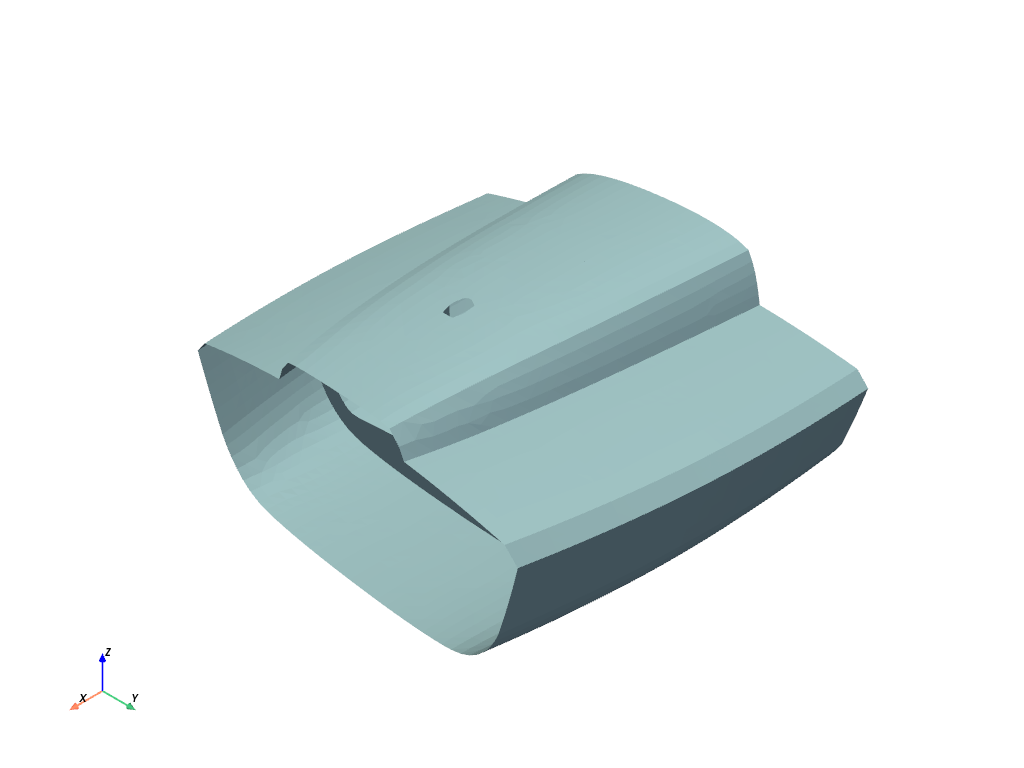
Build Composite Lay-up#
Create the model (MKS unit system).
Materials#
mat_corecell_81kg = model.materials["1"]
mat_corecell_81kg.name = "Core Cell 81kg"
mat_corecell_81kg.ply_type = "isotropic_homogeneous_core"
mat_corecell_103kg = model.materials["2"]
mat_corecell_103kg.name = "Core Cell 103kg"
mat_corecell_103kg.ply_type = "isotropic_homogeneous_core"
mat_eglass_ud = model.materials["3"]
mat_eglass_ud.name = "E-Glass (uni-directional)"
mat_eglass_ud.ply_type = "regular"
Fabrics#
corecell_81kg_5mm = model.create_fabric(
name="Corecell 81kg", thickness=0.005, material=mat_corecell_81kg
)
corecell_103kg_10mm = model.create_fabric(
name="Corecell 103kg", thickness=0.01, material=mat_corecell_103kg
)
eglass_ud_02mm = model.create_fabric(name="eglass UD", thickness=0.0002, material=mat_eglass_ud)
Rosettes#
ros_deck = model.create_rosette(name="ros_deck", origin=(-5.9334, -0.0481, 1.693))
ros_hull = model.create_rosette(name="ros_hull", origin=(-5.3711, -0.0506, -0.2551))
ros_bulkhead = model.create_rosette(
name="ros_bulkhead", origin=(-5.622, 0.0022, 0.0847), dir1=(0.0, 1.0, 0.0), dir2=(0.0, 0.0, 1.0)
)
ros_keeltower = model.create_rosette(
name="ros_keeltower", origin=(-6.0699, -0.0502, 0.623), dir1=(0.0, 0.0, 1.0)
)
Oriented Selection Sets#
Note that the element sets are imported from the initial mesh (CBD file).
oss_deck = model.create_oriented_selection_set(
name="oss_deck",
orientation_point=(-5.3806, -0.0016, 1.6449),
orientation_direction=(0.0, 0.0, -1.0),
element_sets=[model.element_sets["DECK"]],
rosettes=[ros_deck],
)
oss_hull = model.create_oriented_selection_set(
name="oss_hull",
orientation_point=(-5.12, 0.1949, -0.2487),
orientation_direction=(0.0, 0.0, 1.0),
element_sets=[model.element_sets["HULL_ALL"]],
rosettes=[ros_hull],
)
oss_bulkhead = model.create_oriented_selection_set(
name="oss_bulkhead",
orientation_point=(-5.622, -0.0465, -0.094),
orientation_direction=(1.0, 0.0, 0.0),
element_sets=[model.element_sets["BULKHEAD_ALL"]],
rosettes=[ros_bulkhead],
)
esets = [
model.element_sets["KEELTOWER_AFT"],
model.element_sets["KEELTOWER_FRONT"],
model.element_sets["KEELTOWER_PORT"],
model.element_sets["KEELTOWER_STB"],
]
oss_keeltower = model.create_oriented_selection_set(
name="oss_keeltower",
orientation_point=(-6.1019, 0.0001, 1.162),
orientation_direction=(-1.0, 0.0, 0.0),
element_sets=esets,
rosettes=[ros_keeltower],
)
Show the orientations on the hull oriented selection set (OSS).
Note that the model must be updated before the orientations are available.
model.update()
plotter = pyvista.Plotter()
plotter.add_mesh(model.mesh.to_pyvista(), color="white")
orientation = oss_hull.elemental_data.orientation
assert orientation is not None
plotter.add_mesh(
orientation.get_pyvista_glyphs(mesh=model.mesh, factor=0.2, culling_factor=5),
color="blue",
)
plotter.show()
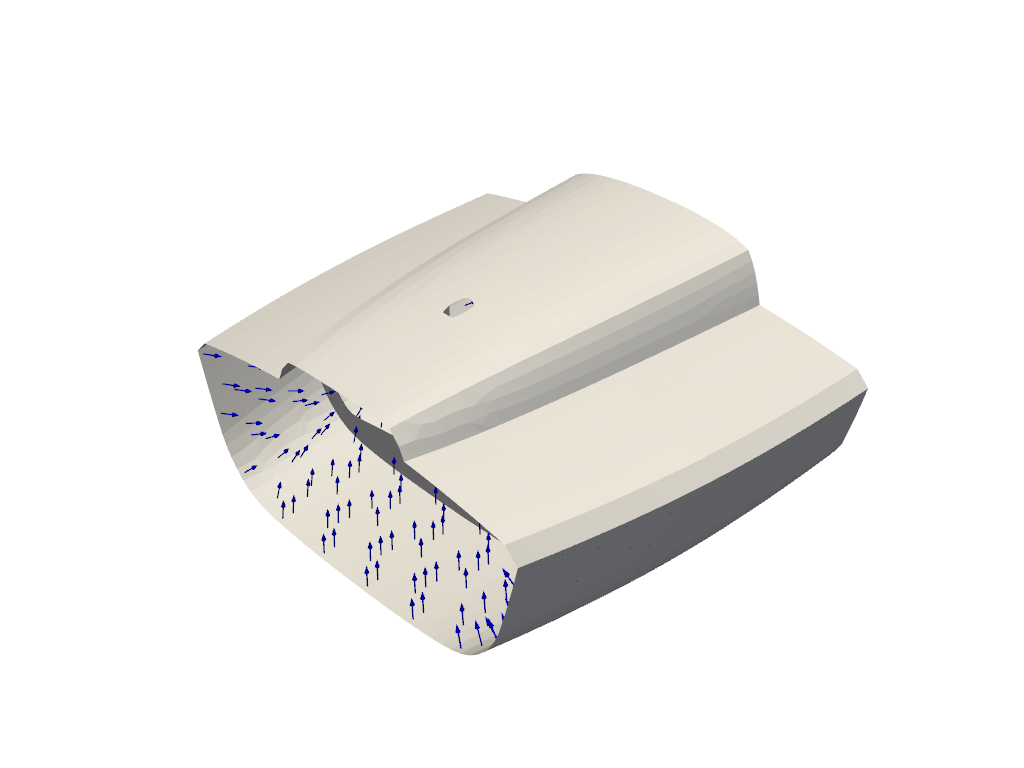
Modeling Plies#
Define plies for the hull, deck, and bulkhead.
angles = [-90.0, -60.0, -45.0 - 30.0, 0.0, 0.0, 30.0, 45.0, 60.0, 90.0]
for mg_name in ["hull", "deck", "bulkhead"]:
mg = model.create_modeling_group(name=mg_name)
oss_list = [model.oriented_selection_sets["oss_" + mg_name]]
for angle in angles:
add_ply(mg, "eglass_ud_02mm_" + str(angle), eglass_ud_02mm, angle, oss_list)
add_ply(mg, "corecell_103kg_10mm", corecell_103kg_10mm, 0.0, oss_list)
for angle in angles:
add_ply(mg, "eglass_ud_02mm_" + str(angle), eglass_ud_02mm, angle, oss_list)
Add plies to the keeltower.
mg = model.create_modeling_group(name="keeltower")
oss_list = [model.oriented_selection_sets["oss_keeltower"]]
for angle in angles:
add_ply(mg, "eglass_ud_02mm_" + str(angle), eglass_ud_02mm, angle, oss_list)
add_ply(mg, "corecell_81kg_5mm", corecell_81kg_5mm, 0.0, oss_list)
for angle in angles:
add_ply(mg, "eglass_ud_02mm_" + str(angle), eglass_ud_02mm, angle, oss_list)
Inspect the number of modeling groups and plies.
print(len(model.modeling_groups))
print(len(model.modeling_groups["hull"].modeling_plies))
print(len(model.modeling_groups["deck"].modeling_plies))
print(len(model.modeling_groups["bulkhead"].modeling_plies))
print(len(model.modeling_groups["keeltower"].modeling_plies))
4
19
19
19
19
Show the thickness of one of the plies.
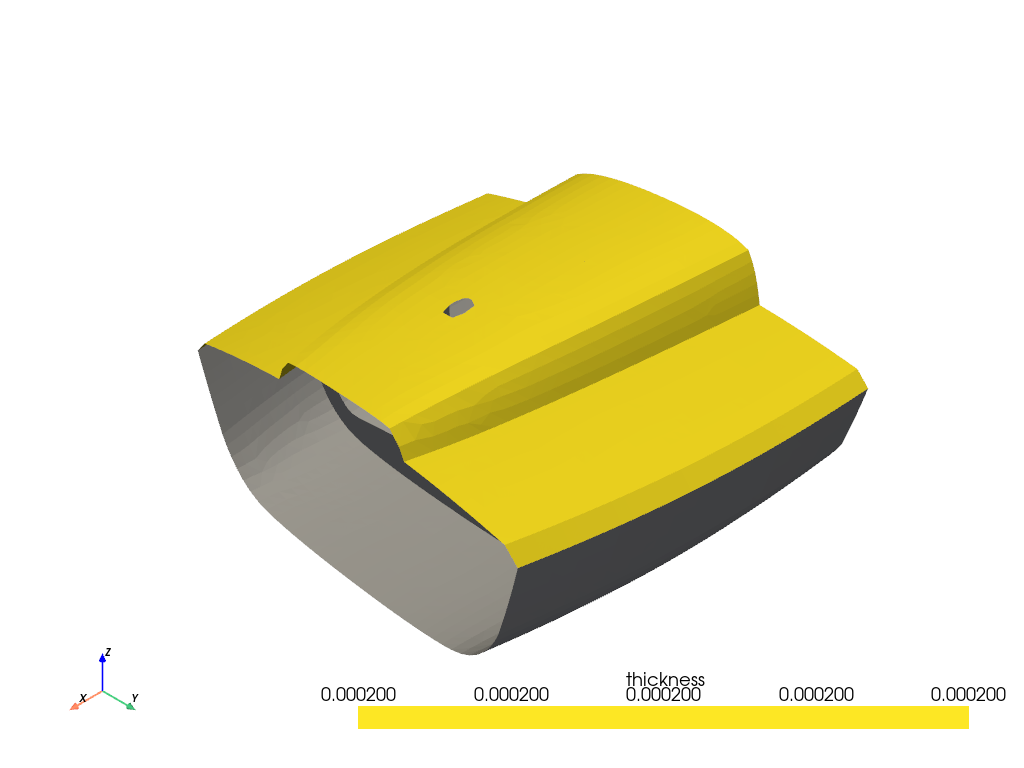
Show the ply offsets that are scaled by a factor of 200.
plotter = pyvista.Plotter()
plotter.add_mesh(model.mesh.to_pyvista(), color="white")
ply_offset = modeling_ply.nodal_data.ply_offset
assert ply_offset is not None
plotter.add_mesh(
ply_offset.get_pyvista_glyphs(mesh=model.mesh, factor=200),
)
plotter.show()

Show the thickness of the entire lay-up.
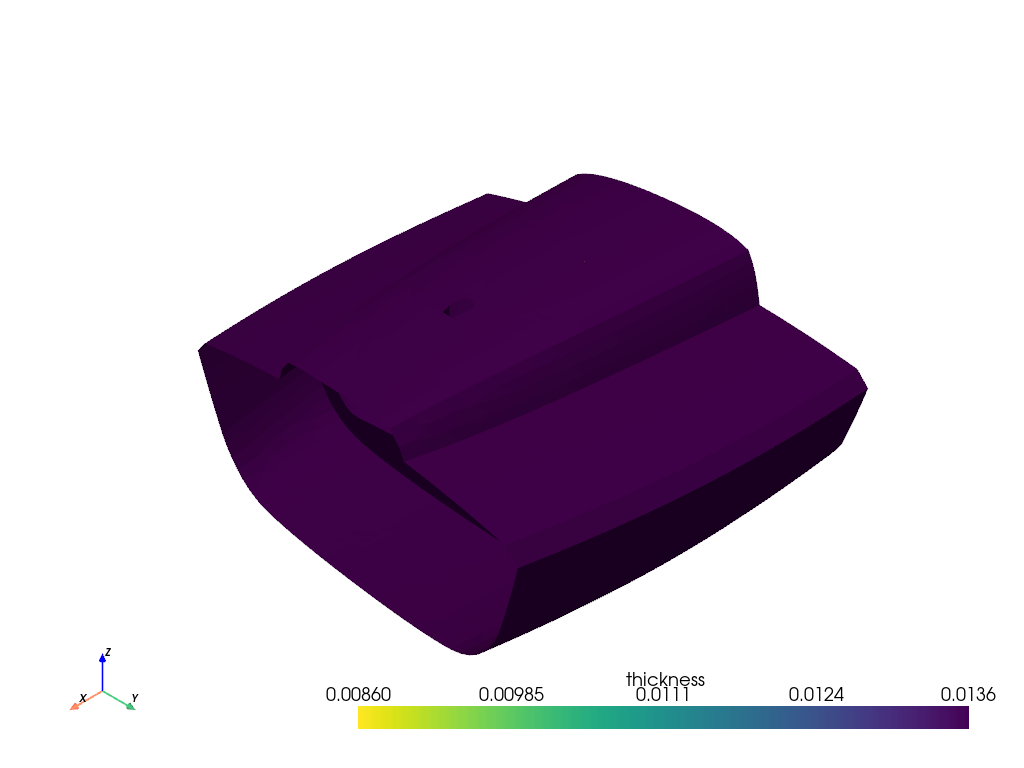
Write out ACP Model#
acph5_filename = "class40.acph5"
cdb_filename_out = "class40_analysis_model.cdb"
composite_definition_h5_filename = "ACPCompositeDefinitions.h5"
matml_filename = "materials.xml"
Update and save the ACP model.
model.update()
model.save(working_dir_path / acph5_filename, save_cache=True)
Save the model as a CDB file for solving with PyMAPDL.
model.export_analysis_model(working_dir_path / cdb_filename_out)
# Export the shell lay-up and material file for PyDPF - Composites.
model.export_shell_composite_definitions(working_dir_path / composite_definition_h5_filename)
model.export_materials(working_dir_path / matml_filename)
Solve with PyMAPDL#
Import PyMAPDL and connect to its server.
from ansys.mapdl.core import launch_mapdl
mapdl = launch_mapdl()
mapdl.clear()
Load the CDB file into PyMAPDL.
mapdl.input(str(working_dir_path / cdb_filename_out))
'\n /INPUT FILE= LINE= 0\n ANSYS RELEASE 11.0 UP20070125 16:39:41 03/10/2009\n *****MAPDL VERIFICATION RUN ONLY*****\n DO NOT USE RESULTS FOR PRODUCTION\n\n ***** MAPDL ANALYSIS DEFINITION (PREP7) *****\n\n\n ***** ROUTINE COMPLETED ***** ELAPSED TIME = 0.000\n\n\n'
Solve the model.
mapdl.allsel()
mapdl.slashsolu()
mapdl.solve()
***** MAPDL SOLVE COMMAND *****
*** NOTE *** ELAPSED TIME = 0.000 TIME= 00:00:00
There is no title defined for this analysis.
*** SELECTION OF ELEMENT TECHNOLOGIES FOR APPLICABLE ELEMENTS ***
---GIVE SUGGESTIONS ONLY---
ELEMENT TYPE 1 IS SHELL181. IT IS ASSOCIATED WITH ELASTOPLASTIC
MATERIALS ONLY. KEYOPT(8) IS ALREADY SET AS SUGGESTED. KEYOPT(3)=2
IS SUGGESTED FOR HIGHER ACCURACY OF MEMBRANE STRESSES; OTHERWISE,
KEYOPT(3)=0 IS SUGGESTED.
ELEMENT TYPE 2 IS BEAM188 . KEYOPT(1)=1 IS SUGGESTED FOR NON-CIRCULAR CROSS
SECTIONS AND KEYOPT(3)=2 IS ALWAYS SUGGESTED.
ELEMENT TYPE 2 IS BEAM188 . KEYOPT(15) IS ALREADY SET AS SUGGESTED.
ELEMENT TYPE 3 IS SHELL181. IT IS ASSOCIATED WITH ELASTOPLASTIC
MATERIALS ONLY. KEYOPT(8) IS ALREADY SET AS SUGGESTED. KEYOPT(3)=2
IS SUGGESTED FOR HIGHER ACCURACY OF MEMBRANE STRESSES; OTHERWISE,
KEYOPT(3)=0 IS SUGGESTED.
*****MAPDL VERIFICATION RUN ONLY*****
DO NOT USE RESULTS FOR PRODUCTION
S O L U T I O N O P T I O N S
PROBLEM DIMENSIONALITY. . . . . . . . . . . . .3-D
DEGREES OF FREEDOM. . . . . . UX UY UZ ROTX ROTY ROTZ
ANALYSIS TYPE . . . . . . . . . . . . . . . . .STATIC (STEADY-STATE)
GLOBALLY ASSEMBLED MATRIX . . . . . . . . . . .SYMMETRIC
*** NOTE *** ELAPSED TIME = 0.000 TIME= 00:00:00
Poisson's ratio PR input has been converted to NU input.
*** NOTE *** ELAPSED TIME = 0.000 TIME= 00:00:00
Present time 0 is less than or equal to the previous time. Time will
default to 1.
*** NOTE *** ELAPSED TIME = 0.000 TIME= 00:00:00
The conditions for direct assembly have been met. No .emat or .erot
files will be produced.
L O A D S T E P O P T I O N S
LOAD STEP NUMBER. . . . . . . . . . . . . . . . 1
TIME AT END OF THE LOAD STEP. . . . . . . . . . 1.0000
NUMBER OF SUBSTEPS. . . . . . . . . . . . . . . 1
STEP CHANGE BOUNDARY CONDITIONS . . . . . . . . NO
PRINT OUTPUT CONTROLS . . . . . . . . . . . . .NO PRINTOUT
DATABASE OUTPUT CONTROLS. . . . . . . . . . . .ALL DATA WRITTEN
FOR THE LAST SUBSTEP
*** NOTE *** ELAPSED TIME = 0.000 TIME= 00:00:00
Predictor is ON by default for structural elements with rotational
degrees of freedom. Use the PRED,OFF command to turn the predictor
OFF if it adversely affects the convergence.
*********** PRECISE MASS SUMMARY ***********
TOTAL RIGID BODY MASS MATRIX ABOUT ORIGIN
Translational mass | Coupled translational/rotational mass
324.96 0.46544E-18 0.14304E-17 | -0.11582E-16 211.44 -0.36088E-02
0.46544E-18 324.96 -0.49693E-17 | -211.44 -0.96175E-17 -2015.3
0.14304E-17 -0.49693E-17 324.96 | 0.36088E-02 2015.3 0.20783E-16
------------------------------------------ | ------------------------------------------
| Rotational mass (inertia)
| 759.66 0.20436E-01 1316.9
| 0.20436E-01 13054. -0.32469E-02
| 1316.9 -0.32469E-02 13218.
TOTAL MASS = 324.96
The mass principal axes coincide with the global Cartesian axes
CENTER OF MASS (X,Y,Z)= -6.2017 0.11105E-04 0.65067
TOTAL INERTIA ABOUT CENTER OF MASS
622.08 -0.19444E-02 5.6093
-0.19444E-02 418.20 -0.89877E-03
5.6093 -0.89877E-03 719.59
PRINCIPAL INERTIAS = 621.76 418.20 719.92
ORIENTATION VECTORS OF THE INERTIA PRINCIPAL AXES IN GLOBAL CARTESIAN
( 0.998,-0.000,-0.057) ( 0.000, 1.000, 0.000) ( 0.057,-0.000, 0.998)
*** MASS SUMMARY BY ELEMENT TYPE ***
TYPE MASS
1 322.570
2 1.65744
3 0.729815
Range of element maximum matrix coefficients in global coordinates
Maximum = 104467551 at element 0.
Minimum = 31671440.9 at element 0.
*** ELEMENT MATRIX FORMULATION TIMES
TYPE NUMBER ENAME TOTAL ELAPSED AVG ELAPSED
1 3973 SHELL181 0.0000 0.000000000
2 88 BEAM188 0.0000 0.000000000
3 22 SHELL181 0.0000 0.000000000
Elapsed Time at end of element matrix formulation = 0.
SPARSE MATRIX DIRECT SOLVER.
Number of equations = 24096, Maximum wavefront = 0
Memory available (MB) = 0.0 , Memory required (MB) = 0.0
Sparse solver maximum pivot= 0 at node 0 .
Sparse solver minimum pivot= 0 at node 0 .
Sparse solver minimum pivot in absolute value= 0 at node 0 .
*** ELEMENT RESULT CALCULATION TIMES
TYPE NUMBER ENAME TOTAL ELAPSED AVG ELAPSED
1 3973 SHELL181 0.0000 0.000000000
2 88 BEAM188 0.0000 0.000000000
3 22 SHELL181 0.0000 0.000000000
*** NODAL LOAD CALCULATION TIMES
TYPE NUMBER ENAME TOTAL ELAPSED AVG ELAPSED
1 3973 SHELL181 0.0000 0.000000000
2 88 BEAM188 0.0000 0.000000000
3 22 SHELL181 0.0000 0.000000000
*** LOAD STEP 1 SUBSTEP 1 COMPLETED. CUM ITER = 1
*** TIME = 1.00000 TIME INC = 1.00000 NEW TRIANG MATRIX
Show the displacements in postprocessing.
mapdl.post1()
mapdl.set("last")
mapdl.post_processing.plot_nodal_displacement(component="NORM")
# Download the RST file for further postprocessing.
rstfile_name = f"{mapdl.jobname}.rst"
mapdl.download(rstfile_name, working_dir_path)

[82, 87, 110]
['file.rst']
Postprocessing with PyDPF - Composites#
To postprocess the results, you must configure the imports, connect to the PyDPF - Composites server, and load its plugin.
from ansys.acp.core.dpf_integration_helpers import get_dpf_unit_system
from ansys.dpf.composites.composite_model import CompositeModel
from ansys.dpf.composites.constants import FailureOutput
from ansys.dpf.composites.data_sources import (
CompositeDefinitionFiles,
ContinuousFiberCompositesFiles,
)
from ansys.dpf.composites.failure_criteria import (
CombinedFailureCriterion,
CoreFailureCriterion,
MaxStrainCriterion,
MaxStressCriterion,
)
from ansys.dpf.composites.server_helpers import connect_to_or_start_server
Connect to the server. The connect_to_or_start_server function
automatically loads the composites plugin.
dpf_server = connect_to_or_start_server()
Specify the combined failure criterion.
max_strain = MaxStrainCriterion()
max_stress = MaxStressCriterion()
core_failure = CoreFailureCriterion()
cfc = CombinedFailureCriterion(
name="Combined Failure Criterion",
failure_criteria=[max_strain, max_stress, core_failure],
)
Create the composite model and configure its input.
composite_model = CompositeModel(
composite_files=ContinuousFiberCompositesFiles(
rst=working_dir_path / rstfile_name,
composite={
"shell": CompositeDefinitionFiles(
definition=working_dir_path / composite_definition_h5_filename
),
},
engineering_data=working_dir_path / matml_filename,
),
default_unit_system=get_dpf_unit_system(model.unit_system),
server=dpf_server,
)
Evaluate the failure criteria.
output_all_elements = composite_model.evaluate_failure_criteria(cfc)
Query and plot the results.
irf_field = output_all_elements.get_field({"failure_label": FailureOutput.FAILURE_VALUE})
irf_field.plot()
# Close MAPDL instance
mapdl.exit()
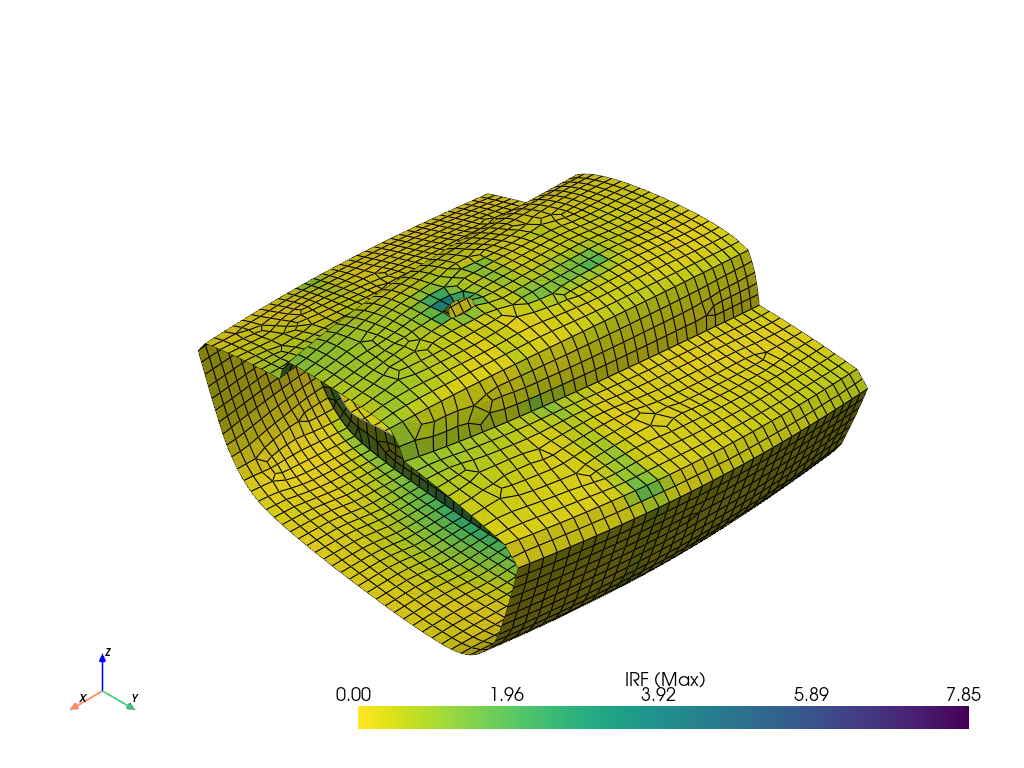
Total running time of the script: (0 minutes 29.381 seconds)

